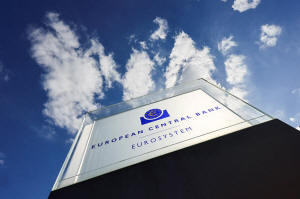ECB to keep floor under market rates but with eye on demand -sources
 Send a link to a friend
Send a link to a friend
 [February 29, 2024] By
Francesco Canepa and Frank Siebelt [February 29, 2024] By
Francesco Canepa and Frank Siebelt
FRANKFURT (Reuters) - The European Central Bank will continue putting a
"floor" under market interest rates in the years to come, but banks will
play a greater role in deciding how much liquidity they want, four
sources told Reuters.
The ECB is reviewing how it steers short-term interest rates in a new
era in which inflation is higher and the massive amount of cash pumped
into the banking system via stimulus programmes over the last decade is
no longer needed and even creates some unwanted side-effects.
For much of the past 10 years the mechanism was simple: The ECB kept
rates at zero or lower and flooded banks with more cash than they needed
via bond purchases and loans, to encourage them to lend and revive
inflation that was then too low.
This removed the need for banks to borrow from the ECB and pinned the
overnight rate that banks charge each other to the one the ECB pays on
deposits.
This framework needs changing now that interest rates are far above zero
and massive amounts of excess reserves are unnecessary -- and are even
causing huge losses to the ECB and some of the 20 central banks around
the euro zone.

Policymakers meeting in Frankfurt last week agreed that the ECB would
stick to a "floor" system, where the central bank effectively sets the
lowest rate at which banks would lend to each other, the sources said on
condition of anonymity because the deliberations are confidential.
But there is an important twist: The ECB will not single-handedly decide
how much liquidity it provides to the banking system once it has
finished draining excess reserves some years from now, the sources
added.
Instead, policymakers agreed commercial banks would help determine that
by borrowing the reserves they need from the ECB, in a similar vein to
what the Bank of England is doing.
To facilitate this, the ECB will make it cheaper for banks to borrow by
lowering the rate on its weekly cash auctions, currently at 4.5%, and
bringing it closer to its 4.0% deposit rate, the sources said.
This so-called "narrow corridor" would reduce the financial penalty and
the stigma for banks that are short of cash, particularly in the
transition phase.
Policymakers also agreed they would tolerate some fluctuations in the
Euro Short-Term Rate (ESTR), the benchmark in the inter-bank market,
around the ECB's own deposit rate.
They expect to announce this new framework -- known in market parlance
as a "demand-driven floor" -- next month, potentially as early as the
ECB's non-policy meeting on March 13, the sources added.
[to top of second column] |

A view shows the signboard of the European Central Bank (ECB), on
the day of the monthly news conference following the ECB's monetary
policy meeting in Frankfurt, Germany, September 14, 2023.
REUTERS/Wolfgang Rattay/File Photo

For now, no change is planned for banks' minimum reserve
requirements, which will remain at 1% of customer deposits. But the
sources said that some individual policymakers are keen for such a
move and may propose it.
The sources added that there was still debate on how big the ECB's
bond portfolio should be and whether it should mostly be comprised
of short-term securities or also of longer-dated ones.
An ECB spokesperson declined to comment.
For now, this discussion is little more than theoretical.
The ECB still owns some 4.7 trillion euros ($5.1 trillion) worth of
bonds, meaning the banking sector as a whole will have more reserves
than it needs until 2029, according to the ECB's own estimates.
This is the result of successive bond-buying programmes through
which the ECB massively increased the amount of reserves in the
banking system to fight low inflation and the financial impact of
the COVID-19 pandemic.
ECB President Christine Lagarde said earlier this month the central
bank will continue to have "a combination of a portfolio of bonds,
but also lending operation of different maturities" on its balance
sheet.
A staff paper found the ECB could halve its stock of bonds by
mid-2026 but would then have to resume purchases to underpin banks'
lending to the economy.
The ECB's rate on bank deposits is currently at a record-high but
ECB policymakers have hinted they expect to start cutting it later
this year.
ECB board member Isabel Schnabel was the first to suggest the
central bank for the euro zone could take a leaf out of the Bank of
England's book in a speech last year.
($1 = 0.9229 euros)
(Editing by Hugh Lawson)
[© 2024 Thomson Reuters. All rights
reserved.]
This material may not be published,
broadcast, rewritten or redistributed.
Thompson Reuters is solely responsible for this content.
 |